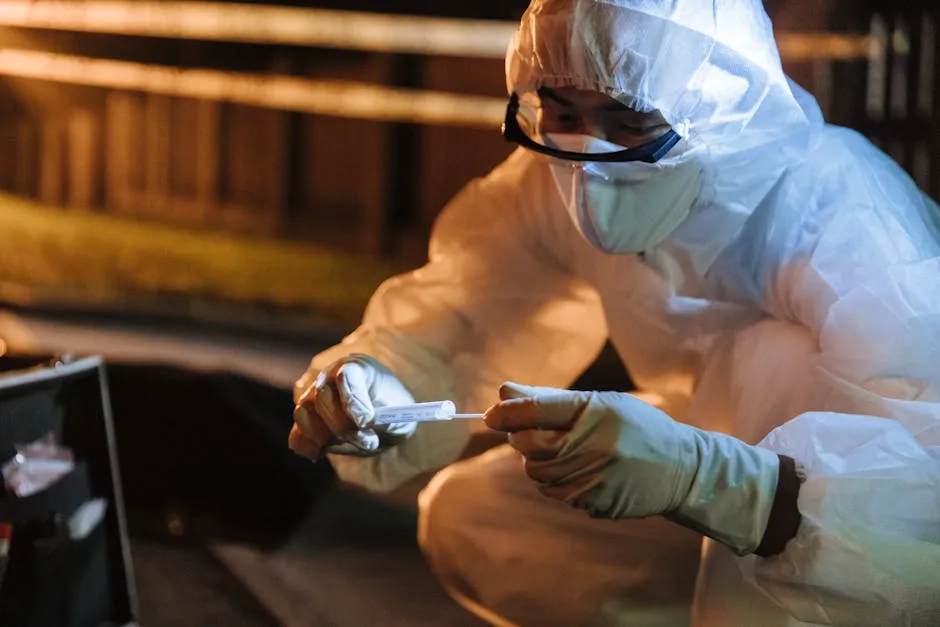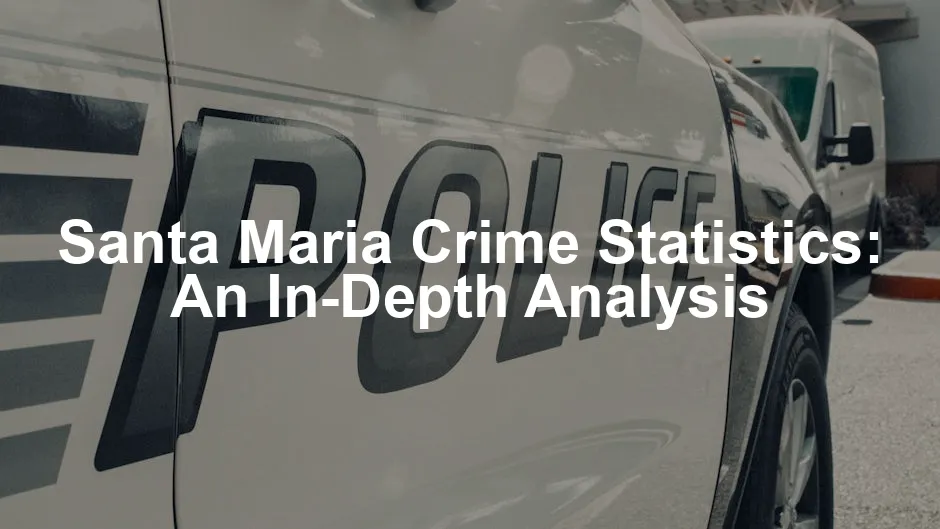Introduction
Nestled in California’s Central Coast, Santa Maria boasts a diverse population of around 106,000 residents. This vibrant city is known for its agricultural roots and is often celebrated for its annual strawberry festival. However, beneath its sunny facade lies a pressing concern for residents: crime.
Understanding crime statistics is crucial for anyone living in Santa Maria, considering a move, or shaping local policy. For residents, these statistics offer insight into their safety. For potential movers, they reveal the risks involved in settling down. Policymakers, on the other hand, use this data to allocate resources effectively and develop strategies to enhance community safety.
Did you know that Santa Maria has a crime rate of 35 per one thousand residents? This startling statistic places it among the highest in the United States. Over 89% of California communities report lower crime rates. As we examine the crime statistics in Santa Maria, we’ll compare them to national and state averages and delve into trends that shape safety perceptions in the city.
By the end of this article, you’ll have a clearer picture of the crime landscape in Santa Maria, equipping you with knowledge crucial for making informed decisions regarding safety and community engagement.

Understanding Crime Statistics
What Are Crime Statistics?
Crime statistics are numerical representations of crime data. They detail the frequency of various crimes in specific areas, providing an essential overview of public safety. Understanding these statistics helps communities assess their safety and informs urban planning efforts.
For instance, local authorities can identify patterns in crime, leading to targeted interventions. This knowledge helps to allocate law enforcement resources effectively, ensuring that communities receive the protection they need.
If you want to dive deeper into the psychology behind criminal behavior, check out The Psychology of Criminal Conduct by D.A. Andrews. This book offers insights that can help you understand the motives behind crime, making it a must-read for anyone interested in criminal justice.
How Crime Statistics Are Collected
Crime data collection relies on standardized methodologies. One notable source is the FBI’s Uniform Crime Reporting (UCR) Program. This program aggregates data reported by law enforcement agencies nationwide. While UCR provides valuable information, it’s essential to recognize its limitations.
For example, not all crimes are reported, leading to potential undercounts. Some agencies may categorize crimes differently, creating inconsistencies. Understanding these nuances is vital for interpreting crime data accurately. Despite these challenges, crime statistics remain a valuable tool for assessing safety and guiding community initiatives.

Santa Maria Crime Overview
General Crime Rates
Santa Maria, California, faces significant crime challenges. With a staggering crime rate of 35 per 1,000 residents, this city ranks among the highest in the nation. To put it in perspective, the chances of becoming a victim of either violent or property crime here are 1 in 29. This statistic is daunting when you consider that over 89% of California communities report lower crime rates.
When we look at violent crime, Santa Maria’s rate stands at 6.47 per 1,000 residents, which is notably higher than the national average. For context, the national average for violent crime is around 4 per 1,000. Property crime rates are equally concerning, with 28.55 per 1,000 residents affected. Comparatively, the national average for property crime sits at approximately 25 per 1,000.
If you’re interested in true crime, look no further than True Crime: An American Anthology. This collection offers a gripping insight into some of America’s most harrowing criminal cases, perfect for those who love to delve into the darker side of human nature.
Overall, Santa Maria’s crime statistics paint a picture of a city grappling with safety issues. It’s crucial for residents and prospective movers to remain aware of these statistics, as they can have a lasting impact on community perceptions and personal safety.

Violent Crime Statistics
When we dissect the violent crime landscape, Santa Maria reports a concerning total of 713 violent crimes annually. These include specific offenses such as:
| Crime Type | Number | Rate per 1,000 Residents |
|---|---|---|
| Murder | 10 | 0.09 |
| Rape | 74 | 0.67 |
| Robbery | 209 | 1.90 |
| Assault | 420 | 3.81 |
| Total Violent Crimes | 713 | 6.47 |
What’s particularly alarming is that Santa Maria’s violent crime rate is about 76% higher than the national average. Over recent years, fluctuations in these numbers have led to increased concerns among residents. For instance, the number of assaults has seen peaks due to gang-related incidents, contributing to a narrative of insecurity.
The accompanying charts and tables illustrate these trends effectively, showing how Santa Maria compares with national and state data. For example, the violent crime rate in California is approximately 6.0 per 1,000, making Santa Maria’s numbers even more alarming.

Property Crime Statistics
Turning our focus to property crimes, Santa Maria experiences a troubling rate of 28.55 per 1,000 residents. A closer look reveals the following breakdown of property crimes:
| Crime Type | Number | Rate per 1,000 Residents |
|---|---|---|
| Burglary | 396 | 3.60 |
| Theft | 1,534 | 13.93 |
| Motor Vehicle Theft | 1,214 | 11.02 |
| Total Property Crimes | 3,144 | 28.55 |
These property crimes outpace national averages, which hover around 25 per 1,000. The most striking statistic? The likelihood of a resident falling victim to property crime is 1 in 35.
In recent years, the trends indicate a rise in vehicle theft incidents, causing alarm among car owners. Statistically, Santa Maria ranks among the cities with the highest rates of vehicle theft in the nation. As residents navigate their daily lives, awareness of these statistics can empower them to take proactive measures in safeguarding their property.

If you’re looking for a gripping true crime read, consider The Innocent Man: Murder and Injustice in a Small Town by John Grisham. This book reveals the dark side of the justice system and how easily one can fall victim to wrongful convictions.
In summary, Santa Maria’s crime statistics reflect a community facing serious safety challenges. Residents should stay informed and work together to foster a safer environment for all.

Detailed Crime Breakdown by Year
Understanding crime trends in Santa Maria is essential for residents and policymakers. Analyzing crime statistics from 2018 to 2022 reveals significant fluctuations. Over these years, the city experienced both peaks and declines in violent and property crimes.
In 2018, Santa Maria recorded a total of 3,900 crimes, including 713 violent crimes. This year marked a concerning spike in violence, causing alarm among residents. The rate of violent crime was approximately 6.47 per 1,000 residents, significantly higher than the national average of 4 per 1,000.
However, in 2019, the overall crime rate saw a slight decline to around 3,800 incidents. This decrease was attributed to increased community policing efforts and neighborhood watch programs. Residents reported feeling safer, and many neighborhoods became more engaged in crime prevention initiatives.
Then came 2020, a year that threw everyone a curveball. The total number of crimes rose again to 4,200, coinciding with societal changes during the pandemic. With more people homebound, property crimes surged, particularly in vehicle theft, which increased to a staggering 1,142 incidents. This was a reflection of broader national trends where cities across the country faced similar spikes in property crime.
The following year, 2021, continued this trend with a further increase in violent crime, reaching 750 incidents. Community leaders expressed concerns about gang activity, which contributed to the violence. In response, the city implemented new outreach programs targeting at-risk youth, aiming to reduce gang involvement.
Finally, in 2022, crime statistics appeared to stabilize. The total number of crimes decreased to 3,800, with a notable drop in violent crimes. This year’s rate of 6.0 per 1,000 residents suggested that community efforts were beginning to pay off. The city also reported fewer gang-related incidents, showing promise for ongoing improvements in public safety.

Graphs illustrating these trends showcase the rollercoaster ride Santa Maria has faced over the past five years. While fluctuations are expected, the community’s resilience and proactive measures are vital in addressing these challenges.
Neighborhood Crime Analysis
Not all neighborhoods in Santa Maria share the same crime rates. Some areas shine as safe havens, while others struggle with higher crime statistics. Analyzing neighborhood crime data helps residents make informed decisions about where to live and how to stay safe.
Among the safest neighborhoods, Sisquoc and Garey stand out as havens of tranquility. With crime rates significantly lower than the city average, residents here often feel secure walking their streets. Other safe areas include Orcutt Ranch Mobile Estates and Foxenwood Estates, where community engagement contributes to lower crime rates.
On the contrary, neighborhoods like downtown Santa Maria and certain sections of North Broadway have garnered a reputation for being less safe. These areas often report higher rates of property crimes and occasional violent incidents. Residents here are encouraged to stay vigilant and adopt safety measures such as neighborhood watch programs.

If you’re intrigued by crime stories, consider reading Crime Scene Investigation: A Guide for Law Enforcement by David Fisher. This book offers a fascinating look into the techniques and strategies used in solving crimes.
Data indicates that the crime rate in downtown Santa Maria was notably higher, with property crimes such as burglaries and thefts being common occurrences. Community leaders are working to address these concerns through increased police presence and community outreach programs.
As the city continues to develop and implement crime prevention strategies, the disparities in crime rates across neighborhoods highlight the importance of localized efforts. Engaging residents in discussions about safety can lead to significant improvements in overall community well-being.

In summary, Santa Maria’s crime statistics reveal a complex landscape that requires ongoing attention and action. By understanding yearly trends and neighborhood dynamics, residents can better navigate their safety and contribute to a more secure environment for all.
Factors Influencing Crime Rates
Socioeconomic Factors
Santa Maria’s crime rates are closely tied to its socioeconomic conditions. High unemployment rates and lower median incomes can create environments where crime flourishes. When people struggle to make ends meet, the temptation to commit crimes often increases. It’s like trying to bake a cake without the right ingredients—something is bound to go wrong.
In Santa Maria, the poverty rate is around 12.7%, slightly lower than the national average of 15.1%. However, that doesn’t mean everyone is living large. Many residents face financial challenges that can push them toward criminal activity. Research shows a strong correlation between poverty and crime, and Santa Maria is no exception. When basic needs are unmet, some may resort to theft or other crimes to survive.
Moreover, the city has a median home price of $359,700, significantly higher than the national average of $184,700. This disparity can lead to feelings of frustration and discontent, fueling crime in the process. A tight housing market only adds pressure on lower-income families, leaving them feeling cornered.

Additionally, the unemployment rate sits at 3.8%, which is lower than the national average of 4.7%. This might seem positive, but the jobs available often do not pay enough to support a decent lifestyle. When individuals feel stuck in a cycle of low wages and high living costs, desperation can lead to criminal choices.
Community and Law Enforcement Response
Local law enforcement plays a crucial role in combating crime. Santa Maria has implemented various strategies to address safety concerns. Community policing is one such approach, aiming to build trust between officers and residents. By fostering these relationships, police can work collaboratively with community members to identify and solve problems.
In addition to traditional policing, Santa Maria has community programs aimed at reducing crime. These include youth outreach initiatives that engage at-risk children and teens. By providing mentorship and support, the hope is to deter them from gang involvement and criminal activities.

If you’re looking for an insightful examination of the criminal justice system, consider Criminal Justice: A Brief Introduction by Frank Schmalleger. This book provides a concise overview of the major aspects of criminal justice, making it an excellent resource for anyone interested in the field.
Community surveys reveal mixed feelings about safety. About 34% of residents feel crime is minimal, while 66% express concerns. This indicates a significant divide in perceptions of safety. The effectiveness of local policing is under scrutiny, with some residents noting that officers are visible yet slow to respond when needed. Others appreciate the increased police presence, believing it fosters a sense of security.
Overall, community sentiment and law enforcement strategies are intertwined. Active community participation can lead to better policing outcomes and ultimately a safer environment for all.

Comparative Analysis
Santa Maria vs. Nearby Cities
When comparing Santa Maria’s crime statistics to nearby cities, the differences are striking. For instance, Lompoc has lower violent crime rates, with statistics showing a rate of 5.9 per 1,000 residents compared to Santa Maria’s 6.47. Arroyo Grande and Guadalupe also report notably lower crime rates, making them appear more appealing to potential residents.
In Santa Maria, the total crime rate sits at 35 per 1,000 residents, while Lompoc and Arroyo Grande report rates of 27.3 and 24.1, respectively. This paints a clear picture: Santa Maria is facing significant safety challenges compared to its neighbors. However, this trend isn’t entirely unique. Many cities in California are grappling with rising crime rates, reflecting broader regional challenges.
Interestingly, Santa Maria’s crime trends have fluctuated over the years, mirroring regional patterns. While some cities may experience spikes in crime due to specific incidents, Santa Maria’s overall crime rate remains a persistent concern.

National Context
When we place Santa Maria’s crime rates within the national context, the picture becomes clearer—and a bit alarming. With a crime rate of 35 per 1,000 residents, Santa Maria ranks among the highest in the United States. It’s like being the star in a horror movie, but not the kind you want to be. Over 89% of California communities report lower crime rates. This stark reality makes Santa Maria stand out for all the wrong reasons.
Significant national trends drive these local crime rates. For instance, the rise in property crimes across the U.S. has been echoed in Santa Maria. After all, if everyone is trying to snatch up some goodies, it’s no surprise that our local crime rate follows suit. Additionally, the impact of socioeconomic factors cannot be ignored. Areas with higher unemployment and poverty rates often see spikes in crime. Santa Maria, with a poverty rate of 12.7% and an unemployment rate of 3.8%, is no exception to this rule.

If you’re interested in the intersection of crime and society, I highly recommend The New Jim Crow: Mass Incarceration in the Age of Colorblindness by Michelle Alexander. This book provides an eye-opening perspective on how systemic issues contribute to crime and incarceration in America.
Moreover, the national spotlight on gang violence adds another layer of complexity. Santa Maria has its share of gang-related issues, which contribute to the violent crime statistics. As cities across the nation grapple with similar challenges, the connection between local and national trends becomes increasingly apparent. Understanding this context is crucial for residents and policymakers alike. It helps shape strategies aimed at improving safety and fostering community engagement.

FAQs
Is Santa Maria safe to live in?
Santa Maria has a higher crime rate than many other communities in California. While some neighborhoods are safer than others, the overall statistics suggest residents should remain alert.
What are the safest neighborhoods in Santa Maria?
Areas like Sisquoc and Garey stand out as safer neighborhoods. Other safe spots include Orcutt Ranch Mobile Estates and Foxenwood Estates. These communities report lower crime rates and a strong sense of community.
How does Santa Maria’s crime rate compare to other California cities?
Santa Maria’s crime rate is notably higher than nearby cities like Lompoc and Arroyo Grande. For instance, Lompoc has a violent crime rate of 5.9 per 1,000 compared to Santa Maria’s 6.47.
What should I do if I become a victim of crime in Santa Maria?
If you become a victim, report the crime to local law enforcement immediately. Document details and seek support from community resources or victim assistance programs.
Conclusion
In summary, Santa Maria’s crime statistics tell a compelling story. With a crime rate of 35 per 1,000 residents, the city faces significant challenges that affect its residents and potential newcomers. While the violent crime rate hovers around 6.47 per 1,000, property crime is even more prevalent, with a rate of 28.55 per 1,000. The statistics reveal that Santa Maria is grappling with safety issues, making it essential for residents to stay informed.
For a deeper understanding of crime statistics, check out this comprehensive analysis of safety in Fremont. fremont crime statistics
For current residents, these statistics serve as a reminder to remain vigilant. Understanding the crime landscape can lead to proactive measures, such as forming neighborhood watch programs or participating in community safety initiatives. For potential movers, these numbers should weigh heavily in your decision-making process. After all, no one wants to move to a place where the chances of becoming a victim are higher than average.
Community engagement plays a crucial role in improving safety. Local organizations and residents must work together to create a safer environment. Hosting town hall meetings, sharing information, and participating in safety programs can foster a sense of unity and awareness. By working together, Santa Maria can take strides toward reducing crime rates.
As we wrap up, it’s vital to encourage ongoing awareness. Stay informed about local crime trends, engage with your neighbors, and don’t hesitate to report suspicious activities. A proactive community is a safer community. Let’s make Santa Maria a place where everyone feels secure and at home. Remember, knowledge is power, and together, we can create a safer Santa Maria for all.
Please let us know what you think about our content by leaving a comment down below!
Thank you for reading till here 🙂
All images from Pexels




